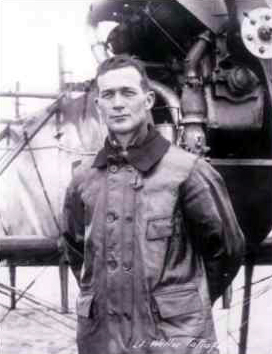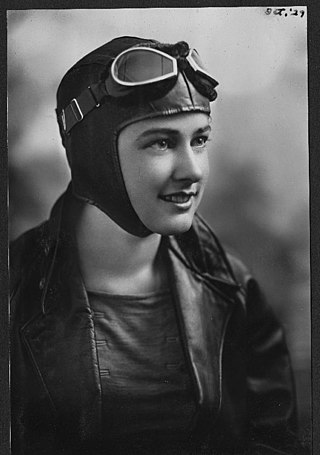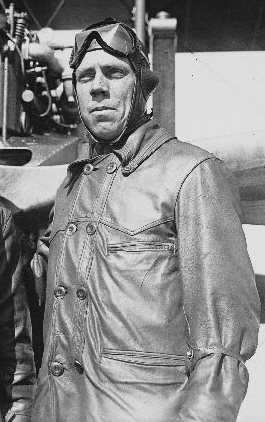
Iris Louise McPhetridge Thaden was an American aviation pioneer, holder of numerous aviation records, and the first woman to win the Bendix trophy, alongside Blanche Noyes. She was inducted into the Arkansas Aviation Historical Society's Hall of Fame in 1980.
This is a list of aviation-related events from 1921:
This is a list of aviation-related events from 1923:
This is a list of aviation-related events from 1908:

Russell Lowell Maughan was an officer in the United States Army and a pioneer aviator. His career began during World War I, and spanned the period in which military aviation developed from a minor arm of the Army Signal Corps to the huge Army Air Forces on the verge of becoming a separate service.

Walter Robertson Taliaferro was a pioneer aviator in the U.S. Army who died in a flying accident. After his first and last "loop the loop" in a Curtiss tractor biplane, the plane suddenly dove into San Diego Bay, killing him instantly.
The "Dawn to dusk" transcontinental flight across the United States was a pioneering aviation record established June 23, 1924. It marked the first crossing of the North American continent within the hours of daylight.

Helen Richey was a pioneering female aviator and the first woman to be hired as a pilot by a commercial airline in the United States.

Albert Francis Hegenberger was a major general in the United States Air Force and a pioneering aviator who set a flight distance record with Lester J. Maitland, completing the first transpacific flight to Hawaii in 1927 as navigator of the Bird of Paradise. Hegenberger was an aeronautical engineer of note, earning both the Mackay Trophy (1927) and Collier Trophy (1934) for achievement. Hegenberger also invented the non-directional beacon, adopted for both military and civil use.

James Floyd Smith was an inventor, aviation pioneer, and parachute manufacturer. With borrowed money, he built, then taught himself to fly his own airplane.

Lowell Herbert Smith was a pioneer American airman who piloted the first airplane to receive a complete mid-air refueling on June 27, 1923, and later set an endurance record of 37 hours on August 28, both in a De Havilland DH-4B. Smith also piloted the Douglas World Cruiser Chicago, which along with one other made the first aerial circumnavigation in 1924. Smith held 16 records for military aircraft in speed, endurance and distance. He was awarded the best achievement in flight Mackay Trophy twice.

The Fokker F.IV is an airliner designed in the Netherlands in the early 1920s, with only two ever made, both for the United States Army Air Service. The aircraft made the first non-stop coast to coast flight of the continental United States in May 1923. The aircraft was powered by a twelve cylinder Liberty engine which was a popular engine for U.S. aircraft at this time.

The LUSAC-11 is an early American two-seat fighter aircraft. It was a French design, commissioned and built in the United States during World War I and ordered in large numbers by the United States Army Air Corps, but these were canceled at the end of the war, and only 30 were built. The type was used for experimental purposes, setting several altitude records during the 1920s.

Oakley George Kelly was a record setting pilot for the United States Army Air Service.

Captain Ernest Emery Harmon, Army Air Corps was an aviation pioneer. Lesser known than many of the major figures of early flight, his significant contributions during the golden age of aviation resulted, by an act of Congress, in the naming of Ernest Harmon Air Force Base in his honor. Dedication ceremonies occurred on August 13, 1949, at the base in Stephenville, Newfoundland.

The Bird of Paradise was a military airplane used by the United States Army Air Corps in 1927 to experiment with the application of radio beacon aids in air navigation. On June 28–29, 1927, the Bird of Paradise, crewed by 1st Lt. Lester J. Maitland and 1st Lt. Albert F. Hegenberger, completed the first flight over the Pacific Ocean from the mainland, California, to Hawaii. For this feat the crew received the Mackay Trophy.

Harold Ross Harris was a notable American test pilot and U.S. Army Air Force officer who held 26 flying records. He made the first flight by American pilots over the Alps from Italy to France, successfully tested the world's first pressurized aircraft, was the first airman to safely escape from an aircraft by "bailing out" using a free-fall parachute. In his civilian career he helped create the first aerial application "crop dusting" business, and later retired as vice-president of Pan American Airways.

Étienne Dormoy was an aeronautical engineer and a designer of aircraft.

Edward Lincoln Hoffman (1884–1970) was a United States Army Air Service (USAAS) pilot, officer and Engineering Division Chief at McCook Field. With no parachute experience, he formed a team that included aviation pioneers Leslie Irvin and James Floyd Smith which developed the first modern parachute. The 1926 Collier Trophy was awarded to Major E. L. Hoffman, Air Corps for "development of a practical parachute;" the year's greatest achievement in American aviation.

Lewis Cassidy Rockwell was a United States Army Second Lieutenant who died in an aircraft crash. Rockwell was the fourth commissioned officer of the United States Army to meet death in an aviation accident. His passenger, Corporal Frank S. Scott, was the first enlisted American to die in an air crash. The crash was the first in the world in which two or more persons were killed.


















